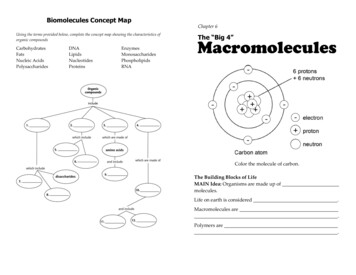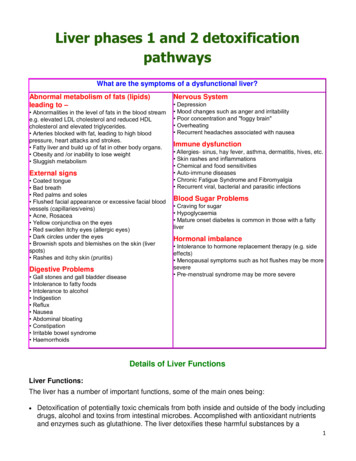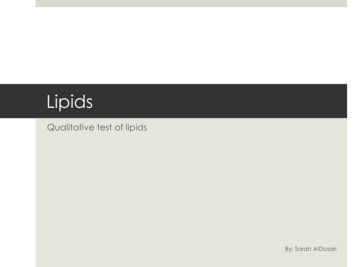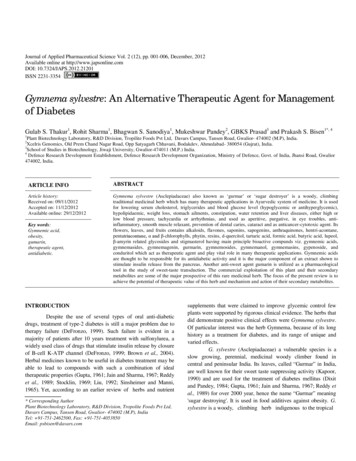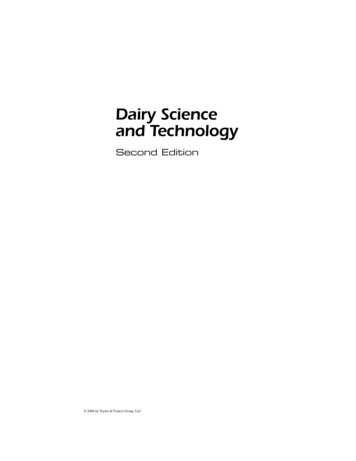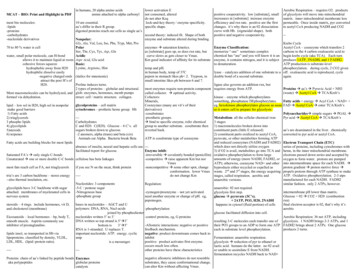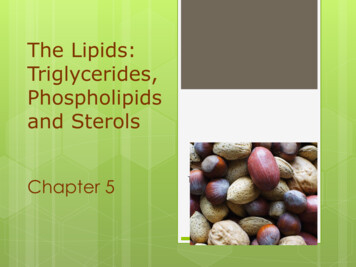
Transcription
The Lipids:Triglycerides,Phospholipidsand SterolsChapter 5The Lipids-Triglycerides,Phospholipids, andSterols
The Lipid Family Triglycerides (fats and oils)Predominate in the body (99%) and in foods (95%)Composed of Carbon, Hydrogen and Oxygen9 kcalories per gram Phospholipids(such as lecithin) Sterols (such as cholesterol)
Chemist’s View of Fatty Acids andTriglyceridesTriglycerides1. Composed of glycerol 3 fatty acids2. Fatty acids may be 4-24 carbons long Even numbers18 carbons fatty acids most common3. Saturated or Unsaturated monounsaturated or polyunsaturated4. Omega-3 and Omega-6 fatty acids are ofimportance in nutrition.5. Essential Fatty acids include:Omega-3-linolenicOmega-6 linoleic
What is a Fatty Acid? Composedof a chain of carbon atoms withhydrogen atoms attached Have an acid group at one end and a methylgroup at the other end. Usually even numbers of carbons
A Fatty AcidStearic acid, an 18- carbon saturated fatty acid.Stearic acid (simplified structure).
Fatty AcidsStearic acidChain Length Long-chains are 12 - 24 carbons in length commonin meats, fish and vegetable oils 18-carbon fatty acids are abundant in food Mediumchains are 6 - 10 carbons coconut Shortand palm oilschains are 6 carbons dairyproducts
The Number of Double BondsDegree of Saturation Saturated fatty acid: contains the maximumpossible number of hydrogen atoms No double bonds Stearicacid; 18 carbon saturated fatty acid
The Number of Double Bonds Unsaturated fatty acid:Has some hydrogen atoms missing and therefore has at least1 double bond Monounsaturated fatty acid:has 1 double bond (missing 2 hydrogen atoms)oleic acid found in olive oil and canola 18carbon monounsaturated fatty acid; oleic
The Number of Double Bonds Polyunsaturated 18 fatty acid:has 2 or more double bondslinoleic acid has 2linolenic acid found in soybean oil has 3carbon polyunsaturated fatty acidlinoleic acidfound in corn, safflower, sunflower, and soybean oils
Stearic acid, an 18-carbon saturated fatty acidOleic acid, an 18-carbon monounsaturated fatty acidLinoleic acid, an 18-carbon polyunsaturated fatty acid
18-Carbon Fatty AcidsTable 5-1, p. 135
Location of the Double Bonds OmegaNumber Polyunsaturated acids are identified by thelocation of their double bond: The omega number indicates the position of the 1stdouble bond in a fatty acidCounting from the CH3 group (methyl group)
Omega-3 and Omega-6 Fatty AcidsCompared
Chemist’s View of Fatty Acids andTriglycerides Triglycerides 1glycerol molecule 3 fatty acids Formed via a condensationreaction Usuallycontains a mixtureof fatty acids (saturatedand unsaturated)
Triglyceride FormationCondensation mations.cfm?id 10&debug 0
A Mixed TriglycerideGlycerolfatty acids (18-c saturated) stearic acidfatty acids(18-c monounsaturated) oleicfatty acids (18-c polyunsaturated) linoleic
Characteristics of solid fats and oilsDegree of UnsaturationFirmness Unsaturated: Liquid at room temperaturePolyunsaturated vegetableoilsVegetable oils make upmuch of the added fat inthe U.S. dietFast-food chains use themfor fryingFood manufacturers addthem to processed foods
Characteristics of solid fats and oilsDegree of saturation influences firmness at roomtemperature More saturated fats are solid at room temperature Animal fats (fat on the meat and fat in dairy)Tropical Oils – palm oil, palm kernel oil, coconut oil, cocoabutter Softer due to shorter carbon chain
Saturated and Unsaturated ComparedDouble bondSaturated fatty acids tend to stacktogether. Consequently, saturatedfats tend to be solid (or more firm)at room temperature.This mixture of saturated andunsaturated fatty acids does notstack neatly because unsaturatedfatty acids bend at the doublebond(s). Consequently, unsaturatedfats tend to be liquid (or less firm) atroom temperature.Fig. 5-4, p. 133
Fatty Acid Composition of CommonFood Fats
Characteristics of solid fats and oils–Stability–––Fat becomes spoiled when exposed to oxygenParticularly polyunsaturatedSaturated fats are most resistant to oxidationTo prevent rancidity food companies: Use air-tight seals and refrigeration Antioxidants are added - BHA, BHT, Vitamin EHydrogenation
Characteristics of solid fats and oils Whatis Hydrogenation?The process of adding hydrogen to unsaturatedfatty acids to make the fat more solid and resistantto the chemical change of oxidation Protects against oxidationAlters texture of the food by making liquidvegetable oils more solidProduces trans fatty acids
HydrogenationDouble bonds carry a slightly negative charge and readilyaccept positively charged hydrogen. Most often fat ispartially hydrogenated, creating a trans-fatty acid.
Cis-and Trans-Fatty AcidsCompared
Characteristics of solid fats and oils Hydrogenated Vegetable Oil Prevents spoilage of unsaturated fats Hydrogenated oil is used in frying Can be heated to high temperatureEasy to handle, easy to spreadOnce fully hydrogenated, an oil loses both itsunsaturated character and health benefitsThe stick margarines may contain almost 50% of theirfat as trans fat
Phospholipids Phospholipids –Cell membranesHelp lipids move across cell membranes,– are soluble in both water and fatsuch as vitamins, and hormonesEmulsifiers-keep fat suspended in body fluids
Lecithin
Phospholipids Phospholipids in foodFound in foods such as eggs, liver,soybeans, wheat germ, peanutsUsed in food industry as emulsifiers in foodssuch as mayonnaise and salad dressingsand candy bars
Sterols Sterols in Food:Most common one is cholesterol; Foundonly in foods of animal origin Meat, eggs, fish and poultry, dairy Plant sterols (phytosterols) Naturallyfound plants but in very low levels Plant sterols block cholesterol absorption Plant sterols have been added to common foodssuch as vegetable oil spreads, dairy drinks, snack bars
Sterols Roles of sterols:Cholesterol ( component of cell membranes) Made in the liverBile acidsSex hormonesAdrenal hormonesVitamin D Cholesterolcan be used as the starting materiel tomake these compounds
Cholic Acid and the SexHormones
Cholesterol Content of Common Foods
LipidDigestionIn theGI Tract
The Emulsification of Fat by BileFatWatery GIjuicesEnzymesIn the stomach,the fat andwatery GI juicestend to separate.The enzymes inthe GI juicescan’t get at thefat.EnzymeFatBileEmulsifiedfatWhen fat entersthe small intestine,the gallbladdersecretes bile. Bilehas an affinity forboth fat and water,so it can bring thefat into the water.EmulsifiedfatBile’s emulsifyingaction convertslarge fat globulesinto small dropletsthat repel eachother.EmulsifiedfatAfteremulsification,more fat isexposed to theenzymes, makingfat digestion moreefficient.Stepped ArtFig. 5-14, p. 150
Hydrolysis of a Triglyceride
Bile’s RoutesEnterohepaticcirculationReabsorbed andrecycled
Absorption of Fat
Lipid Absorption Directly into bloodstreamGlycerol and short- & medium-chain fattyacids Lymphatic systemMicelles diffuse into intestinal cellsReassembly of triglyceridesPacked with proteins – chylomicronsBypass liver at first
Fat imations.cfm?id 11&debug 0
A Typical einA typical lipoprotein contains aninterior of triglycerides andcholesterol surrounded byphospholipids. Thephospholipids’ fatty acid “tails”point towards the interior, wherethe lipids are. Proteins near theouter ends of the phospholipidscover the structure. Thisarrangement of hydrophobicmolecules on the inside andhydrophilic molecules on theoutside allows lipids to travelthrough the watery fluids of theblood.Fig. 5-18b, p. 146
Lipid TransportFour Main Types of LipoproteinsChylomicrons: Largest& Least Dense Transport diet derived lipid (Trig) from theintestine, through the lymph, to the blood andthe rest of the body As chylomicrons pass through bloodstream,cells remove lipids from them Liver cells remove the remnants from theblood and reassemble them into newtriglycerides
Lipid TransportVery Low Density Lipoprotein (VLDL) Madein Liver Transport lipids from the liver to the rest of the body AsMainly triglyceride (50%)VLDL travel throughout the body, cells removetriglyceride As they lose triglyceride, the proportion ofcholesterol increases and they become a lowdensity lipoprotein (LDL).
Lipid TransportLow Density Lipoprotein (LDL) Composedprimarily of cholesterol Circulate throughout the body and releasetriglyceride, cholesterol and phospholipid tobody cells. Body cells collect the lipids and use them tomake cell membranes, hormones, or store forlater use. Liver removes LDL from circulation Often termed “Bad Cholesterol” because this isthe lipoprotein that is linked to heart disease.
Lipid TransportHigh Density Lipoprotein (HDL) Livermakes HDL to remove cholesterol fromthe cells and bring it back to the liver forrecycling or disposal By decreasing cholesterol in the arteries, HDLlowers heart disease risk; often called the“Good Cholesterol”
Size Comparisons of the Lipoproteins
Lipid Transport
Health Implications HighLDL is associated with high risk High HDL is associated with low risk Factors that lower LDL and or Raise HDLWeight controlMono or polyunsaturated fat instead of saturatedSoluble fiberPhysical ActivityModerate Alcohol
The Role of Triglycerides
Essential Fatty AcidsLinoleic acid and Linolenic acid Fattyacids that the bodycannot make or cannotmake in sufficient quantities Must be supplied by the diet Found in plant and animalsources Vegetable Oils, Nuts, Seeds,Fish, Seafood, Meats With adequate linoleic acidand linolenic acids, the bodycan make other members ofthe lipid family (such asArachidonic)
Essential Fatty AcidsLinoleic Acid- Omega 6 fatty acid Vegetableoils and meatsLinolenic Acid- Omega-3 fatty acid Canola,Soybean, Nuts, Seeds Fish Oils-Salmon, Mackerel, Menhaden,Tuna, Sardines, and Lake Trout Essentialfor normal growth and development,especially eyes and brain May help with prevention and/or treatment ofheart disease, hypertension, arthritis, and cancer
Omega -3 Fatty Acids Withadequate linolenic acid, thebody can make other members of theomega-3 family such as: DHA: docosahexaenoic acidEPA: eicosapentaenoic acidUsed to make “eicosanoids”- biologically activecompounds Help lower blood pressure Prevent clot formation Protect against irregular heartbeats Reduce inflammation
Essential Fatty Acids Fatty Acid DeficiencyU.S. diets meets essential fatty acid needsHistorically, deficiencies developed in children fedfat-free milk or in hospitalized patients fed fat freeformulasSymptoms:Growth retardationReproductive FailureSkin lesionsKidney DiseaseNeuro and visual problems
Lipid MetabolismStoring Fat as Fat: Fat is stored as triglyceride in adipose tissue. Adipose tissue has an unlimited capacity to storefat. Lipoprotein Lipase-An enzyme on the surface ofthe adipose cell Inside the cell the pieces are reassembled intotriglyceride for storage or energy use
An Adipose CellTriglycerides can bemade from:CarbohydrateProtein, and Fat
Lipid MetabolismUsing Fat for Energy: Fat provides 60% of energy needs during rest Glycerol and fatty acids are released directly intothe bloodstream for cells to use for energy 1 pound of fat 3500 kcal. Only the glycerol portion of triglyceride can beconverted to glucose for brain, nerve and RBCs the fatty acids cannot be converted to glucose.
Health Effects of Saturated FatsHeart Disease Leadingcause of death in adults Elevated LDL cholesterol is a major riskfactor for heart disease Cholesterol based plaque builduprestricts and blood flow and raisesblood pressure Saturated fats raise LDL cholesterollevels much more dramatically thanfood cholesterol and promote bloodclotting
Health Effects of Saturated Fats Sources of Saturated fats:Whole milk, cream, butter, cheeseFatty cuts of beef and porkCoconut, palm and palm kernel oils-candies, pastry,pies, doughnuts, cookies Desirable blood lipid profileTotal cholesterol 200 mg/dLLDL cholesterol 100 mg/dLHDL cholesterol 60 mg/dLTriglycerides 150 mg/dLBlood lipid profile
SaturatedFatsIn theU.S. Diet
Health Effects of Saturated Fats Risksfrom Trans Fats Trans-fatty acids in the dietincrease LDL cholesterol and decrease HDL cholesterol. Foodsources include deep-fried foods usingvegetable shortening, cakes, cookies, doughnuts,pastry, crackers, snack chips, margarine Butter versus margarine Soft –liquid or tubTrans fat freeLiquid vegetable oil as 1st ingredient 2 grams saturated fatFood sources of cholesterol include: egg yolks, milk products, meat, poultry and shellfish.
Health Effects of Saturated FatsCancer Does not seem to initiate cancer but maypromote it once it has arisen Colon Cancer- associated with animal fat Breast Cancer-association is unclearObesity Fat 2 x kcal of Protein or Carbohydrate High fat diets may exceed energy needsand lead to weight gain
Recommended Intakes ofSaturated Fats Recommended TheIntakes of FatDRI and the Dietary Guidelines recommend: 20-35%of energy intake from fat Limiting 10% of energy intake from saturated fat As little trans fat as possible Less than 300 mg of cholesterol
Health Effects of Mono andPolyunsaturated Fats Heart DiseaseReplacing both saturated and trans fats withmonounsaturated and polyunsaturated fats reduces LDLcholesterol and lowers heart disease riskMonounsaturated Olive oil, canola oil, peanut oil, avocadosPolyunsaturated Safflower,sesame, soy, corn, sunflower oils, nuts, seeds
Health Effects of LipidsBenefits from Omega-3 Fatty AcidsReduced risk of heart disease Helps prevent blood clots, lowers blood pressureimprove blood lipids, suppress inflammation Sources include canola, soybean, flaxseed oils,walnuts, fatty fish (mackerel, salmon, sardines) Supplements not recommended unless advised byphysician Can increase bleeding time, interfere with woundhealing, impair immune function
Sources of Omega- 3 and Omega- 6 Fatty Acids
Recommended Intakes of Mono& Polyunsaturated Fats 20 to 35 percent of kcalories from fatIncludes essential fatty acids DRI Linoleic acid – 5-10% of daily energyLinolenic acid – 0.6-1.2% of daily energy
Replacing Saturated withUnsaturated Fat
Replacing Saturated with Unsaturated Fat
From Guidelines to Groceries Choose lean cuts of meatHave 2 servings of fish per weekChoose fat-free and low-fat milks and milkproductsVegetables, fruits, and grains Invisible fat Lowers consumption of various fats in the dietFried and baked goodsChoose wisely Unprocessed foods
Fat in Ground Meats
Fast Food: Breakfast/Pizza Choices
Fast Food: Taco/Burger Choices
Counting College Calories Krispy Creme glazed doughnut:Starbucks Grande Frappuccino:McDonald’s Big Mac:Super size fries:Jack in Box taco:Subway steak and cheese:2 large pieces of Dominospizza pepperoni200 Kcal270 Kcal530 Kcal610 Kcal170 Kcal412 Kcal12 g fat4 g fat33 g fat29 g fat9 g fat18 g fat614 kcal24 g fat
High-Fat Foods and Heart Disease
The Mediterranean Diet Traditionally Low in saturated fatVery low in trans fatRich in unsaturated fatRich in complex carbohydrate and fiberRich in nutrients and phytochemicals Benefitsfor heart disease risk
Mediterranean Diet Plan
Calculate Personal Daily Value for Fat1800 total kcal X 0.30 from fat 540 kcal540 fat kcal9 kcal per gram 60 g fatkcal/day15001800200022002400280030% from fat450540600660720840fat g/day506065738093
Fat ReplacersOlestra:Artificial fat.Sucrose molecule with 6-8 fatty acids attachedDigestive enzymes are unable to break bonds.Passes through undigested.Looks, feels, tastes like fatHigh heat stable-fry, cook, bakeProvides 0 kcal.Used in snack foods, chips, crackersMay cause digestive distress: cramps, bloating,gas, diarrhea, fecal urgency, and anal leakageBinds with fat soluble vitamins (A, D, E, K)
End of Chapter 5p. 164
the U.S. diet Fast-food chains use them for frying . After emulsification, more fat is exposed to the enzymes, making fat digestion more efficient. Enzyme Emulsified fat Bile .


